Automobile benchmarking company Munro & Associates is well known for having criticized the Tesla Model 3, with founder Sandy Munro calling the car’s quality flaws similar to “A Kia in the ’90s.” But now Munro has a Tesla Model Y, and after looking at it and talking with Munro experts, I’m convinced that the Y is much improved from the Model 3 on which it is based.
The Tesla Model Y wasn’t torn down when I had a look at it, but I still got to walk around with Munro President Cory Steuben, who showed me some standout technical features, particularly ones that differ from what’s on the Model 3. Let’s take peek at the interesting hardware that I saw, and that Munro’s founder Sandy discovered after I left.
The Rear Part Of The Car Is A Smarter Design
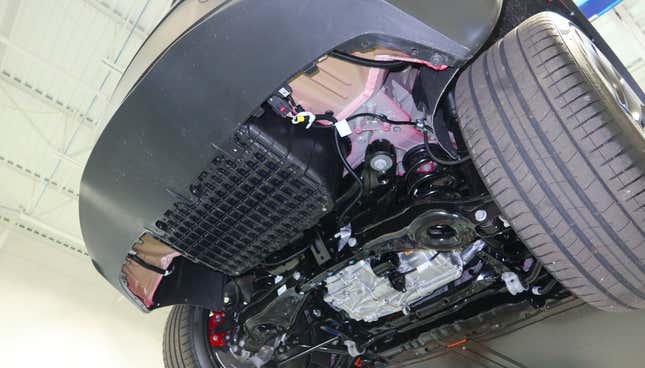
One of the main criticisms that Sandy voiced about the early Tesla Model 3 that his company analyzed was the way its rear body structure was put together with a hodgepodge of rivets, welds, and fasteners, and how the wheel wells were made of far too many pieces, as Wards Auto points out:
Walking members of the Automotive Press Assn. over that Model 3’s body-in-white here at his firm’s Detroit-area headquarters, Munro points out self-piercing rivets in the trunk area/rear of the car that are inexplicably raised and lowered, as well as an unusual mix of conventional and concentric-circle aluminum spot welds and riv-nut and clinch-nut fasteners. Of the latter, Munro says, “I don’t understand the rationale there.”
He also points out nine different parts make up the wheel wells, a contrast to what normally would be a single-piece structure in most vehicles, and notes laser-made wave welds are used in lieu of spot welds and self-piercing rivets on the upper door ring on the left passenger side of the car.
Motor Trend also did a breakdown of Munro’s criticism of the Model 3's body structure. From the site:
Luggage Well—This well is composed of numerous metal stampings that are time consuming to form and assemble. Munro recommends replacing this well with a simpler structural composite tub.
The back end of the car was just far too complex and contained too many pieces and joining methods. It didn’t need to be that way. Munro says it sent a book of hundreds of manufacturing improvement ideas to Tesla and, at least according to the benchmarking company, it appears Tesla paid attention.
Musk even Tweeted his appreciation for Munro’s ideas:
Among the changes to the Y over the 3 is the addition of a nylon drop-in rear cargo tub.
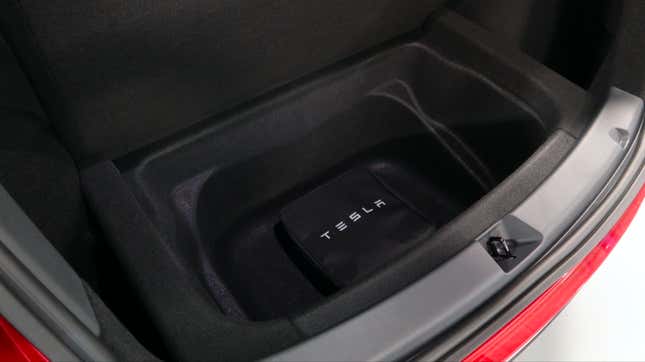
That nylon tub makes the rear part of the body significantly simpler compared to the Model 3's multi-piece tub, which was part of the floor structure. The Y’s plastic tub simply bolts into the body, and is easier to replace if needed, Steuben told me.
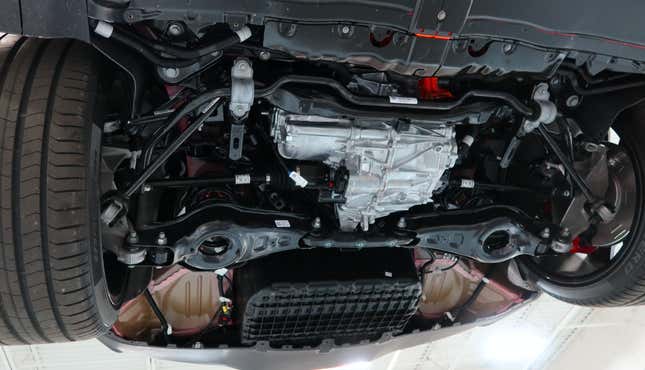
“When I saw the Tesla 3, I really, really was unhappy with the way that they did the back end of the car...I saw hundreds of parts that shouldn’t have been there. I was really unhappy,” Sandy says in a recent video on his company’s new YouTube channel, Munro Live.
“I suggested that they get rid of the aluminum boot that I couldn’t even count the number of parts inside of it. But they’ve taken that and pulled it out...we made a suggestion to go to something like this. We think this is a nylon with glass filled boot, one piece, drop it in, all done,” he continues.
Talking about the rear section of the car that used to be made of far too many components, Sandy likes what Tesla has done. “This...gigantic aluminum casting that takes up probably a third of the back end of the car, I am really thrilled with,” he says, pointing out holes cast into the pan that should help Tesla line up the casting to get it in exactly the right spot every time.
Suspension
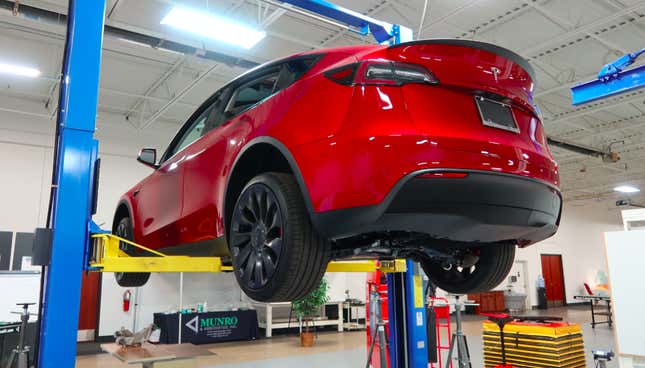
The Tesla Model Y has 1.1 inches of extra ground clearance compared to the Model 3, and it’s also got a couple of inches of extra track width. Plus, the SUV weighs about 300 pounds more than the 3, so naturally you’d expect there to be some suspension differences between the two models.
And indeed, there are some.
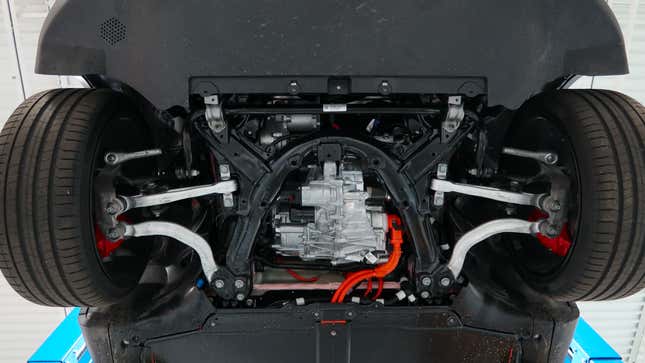
As Sandy points out in the video below, the front suspension geometry—using a virtual steering axis as is common in sports sedans (the new BMW 3 Series uses a similar setup)—looks largely the same, though the cast aluminum control arms are different (even having different part numbers), and Tesla has changed out some zip ties in favor of bolts to hold a damper to the upper control arm.
Here’s that damper on the Model 3. Yes, it’s literally just a mass strapped to the upper control arm. This is called a “tuned mass damper,” and its job is to reduce vibrations/noise entering the cabin by changing the control arm’s natural frequency so that it doesn’t “line up” with the frequency of vibrations seen in the car, as this could cause “constructive interference.”
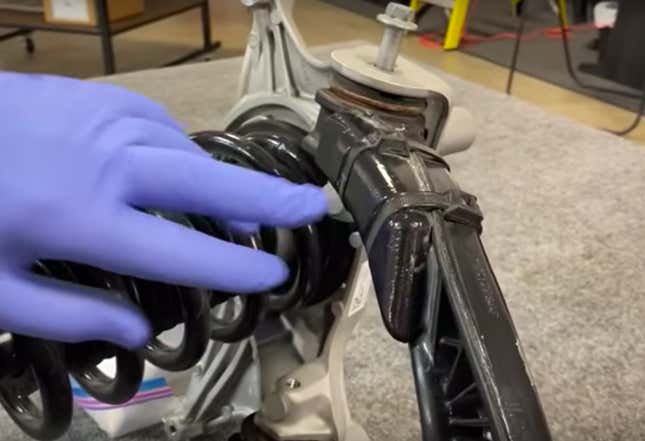
I spoke with with reader Dylan Thanushyan—who’s spent time as a chassis engineer for Jaguar and McLaren, among other companies—to gain more insight into what I might be looking at here. Here’s what Thanushyan told me:
If it’s physically only attached by those cable ties, it’s likely to be a late addition of mass damper (hence the attachment method, and likely to be revisited in later models).
Im sure an NVH requirement may have identified a noise transfer function through the UCA (especially looking at its design) into the shock tower and ultimately work its way into the occupant cabin. I bet that mass suppresses some kind of noise or vibration given a certain driving case.
It’s not uncommon to see large OEMS throwing various mass dampers like this throughout the vehicle. Could easily be avoided with the correct process.
Here’s a look at how the Model Y cleaned up the design. Though the mass damper remains, the rather shoddy looking zipties are now gone, replaced by torx screws (later Model 3s also got torx screws, I’m told):

You’ll also notice in the photos above that the stamped steel upper control arm has some kind of webbing on its underside. This setup looks quite similar to the steel/nylon upper control arms seen in the new Ram 1500 “DT” that we showed at the 2018 Detroit Auto Show. Munro confirmed to me that this is a steel and plastic control arm in the 3 and Y.
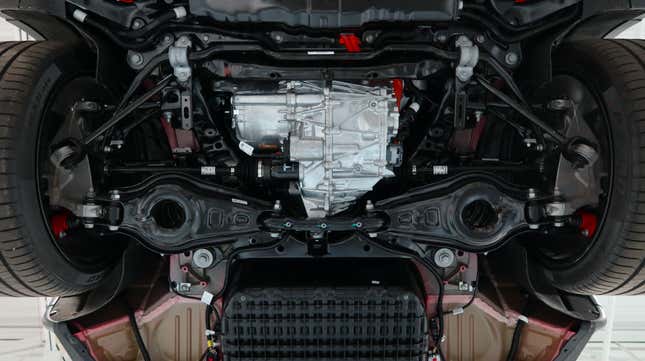
As for the rear suspension geometry, it’s largely shared with the Model 3. In fact, the lower control arms in the photo above and below are labeled “Model 3,” so they’re common parts between the two vehicles—a smart way to save on cost, Sandy notes.

The rest of the rear suspension links look the same between the 3 and Y, except for one that Munro & Associates labels the “upper angled link control arm.” You can see how it’s just a dogbone-style on the Model 3 Long Range:
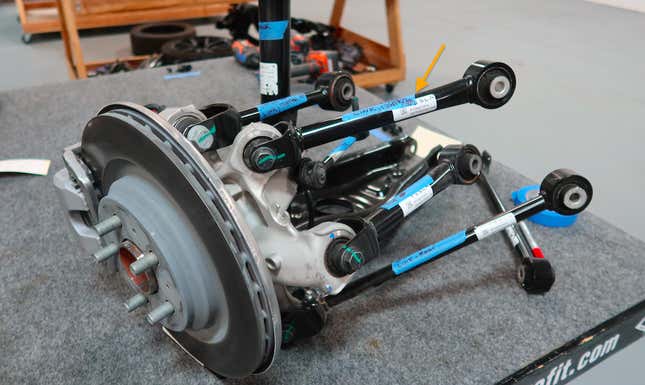
And on the Tesla Model Y Performance it’s got a more complex, stamped shape instead of having the end of the dogbone welded to the tubular bar:
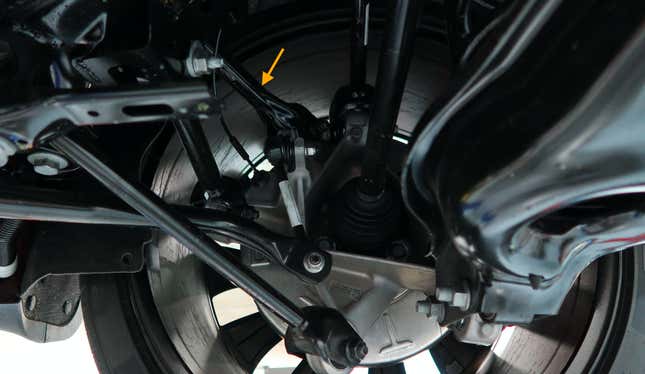
Here’s a closer look:
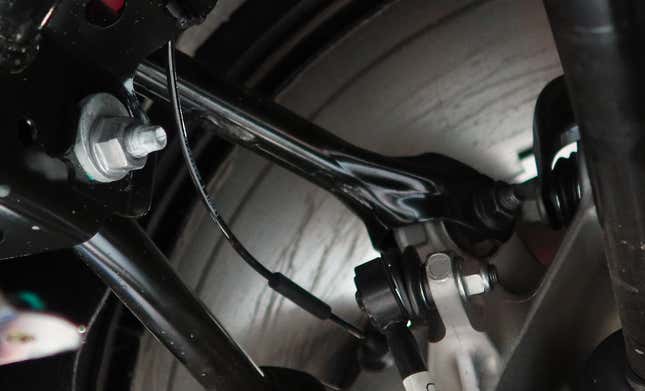
It’s worth noting that some Model 3s also used this stamped link. Steuben says Tesla likely made this change at some point after Munro’s early Model 3 was built.
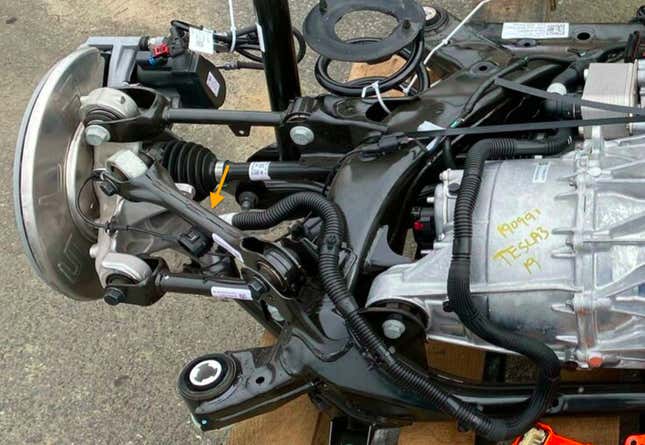
As for changes to the Y’s track width and ride height, Steuben wasn’t entirely sure where those geometry differences came from. Though many of the “dogbone” rear suspension control arms look the same, there’s a chance they have different lengths than the Model 3's.
Munro’s president did note that the front knuckle and rear wheel wheel bearing carrier (or “rear knuckle” as Munro calls it) are definitely different than those of the 3, and it’s likely that it’s here where the Model Y gains much of its extra track width.
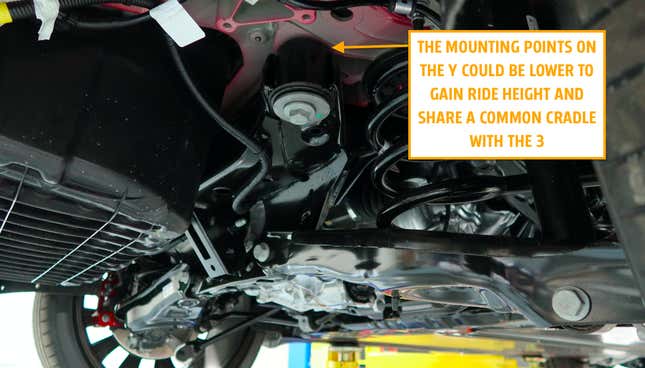
As for how the Y gained 1.1 inches of ride height over the 3, that’s not clear yet either. According to Steuben, the Model S and X have common rear suspension cradles and different cradles up front, so it’s possible that the Y and 3 share a rear subframe as well, but that the actual mounting points are lower on the Y’s body. (In other words, instead of having spacers between the subframe and the body to gain ride height, the body itself could have spacers “built in,” so to speak). We’ll learn more when Munro starts tearing into the suspension.
Well-Packaged Heat Pump System

One bit of engineering that Steuben was keen to point out to me was the heat pump. Such a system is not unique to Tesla, as Nissan offers something like it in its Leaf and VW also has a heat pump in its MEB vehicles. Still, though we didn’t get into the system’s details, Steuben did marvel at its packaging.
“This whole heat pump is packaged in the space of a suitcase and it’s incredible,” he told me, going on to say that the layout is “second to none.”
The heat pump’s job is to use ambient air and heat from the vehicle’s powertrain to warm up the cabin, preventing the vehicle from having to rely on a resistance element that saps up precious current from the battery. It essentially works like an air conditioning system in reverse, and is a great way to add range in the winter time. VW has a heat pump on its e-Golf, and describes it thusly:
...offered as an add-on module for the electric heating (high-voltage heater) and the electric air conditioning compressor, the heat pump utilises both the heat from the ambient air and the heat given off by the drive system components. In this way the high-voltage heater’s consumption of electric power is significantly reduced. Through use of the heat pump the e-Golf’s range increases in winter by up to 20 per cent.
Here’s Nissan’s basic heat pump diagram. Notice that electricity at “2" is being used to compress the refrigerant that has picked up heat from its source. This increases the refrigerant’s temperature before it enters the cabin heater, which improves range in the winter by reducing reliance on resistance heating.
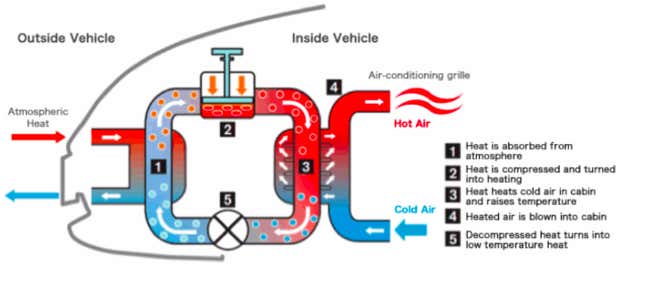
Sandy Munro, in his video, shows off how the Model Y’s system is packaged in the car, just below the cowl. He also compares the compressor to that of the Model 3:
Missing from the Model Y’s compressor—which, it’s worth noting, is isolated from the body to keep its vibrations from affecting cabin comfort—is a foam cover. Sandy says he’s heard some complaints about the Y’s compressor noise, and Steuben tells me the heat pump has the compressor kicking on quite a bit more often than it does on the 3 (which makes sense, as the 3 doesn’t have a heat pump).
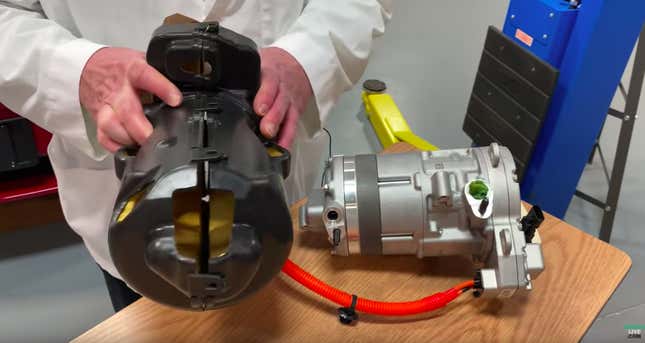
As Sandy notes, it’d be interesting to see if a Model 3-esque foam cover on the isolated Y compressor, shown below, could have reduced some of these complaints.
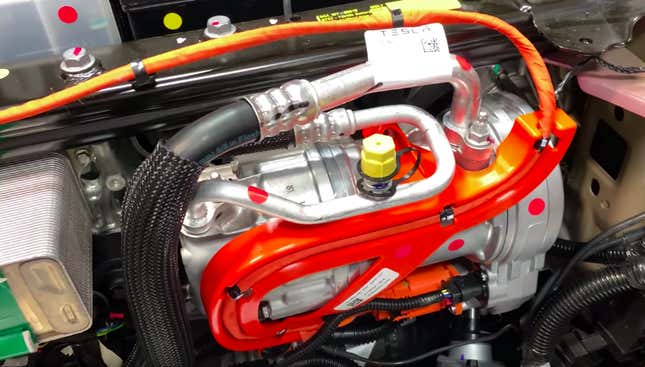
Better Fit And Finish, Still Some Issues with the paint
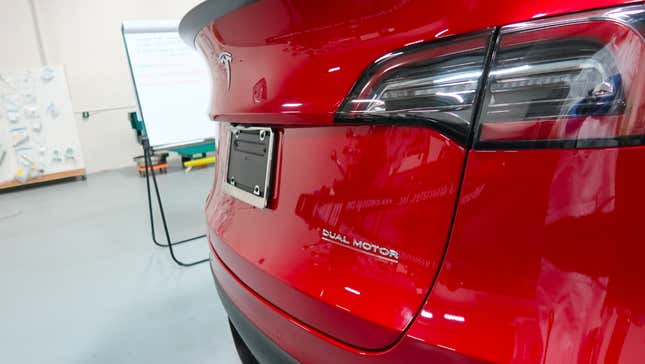
Munro’s early example of a Tesla Model 3 (it was VIN #1,100) got bashed hard for its fit and finish issues, but the benchmarking firm has been pleasantly surprised with the Y’s improvement over its smaller sibling, with Steuben referring to the car’s fit and finish as “really great.”
The rear hatch isn’t perfect, though. We measured the gap between the two parts of the left taillight, and came up with a 2mm reading.
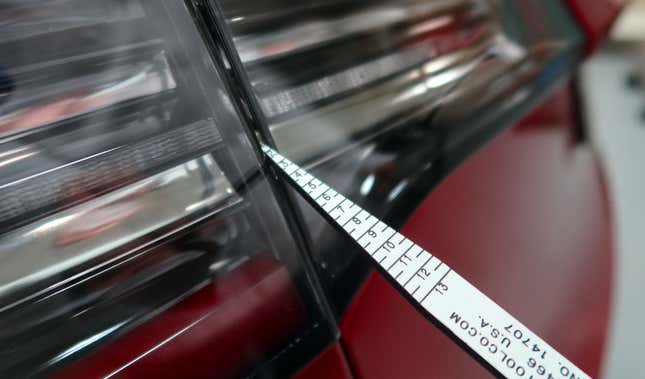
On the right side, that figure grew to about 6 mm.
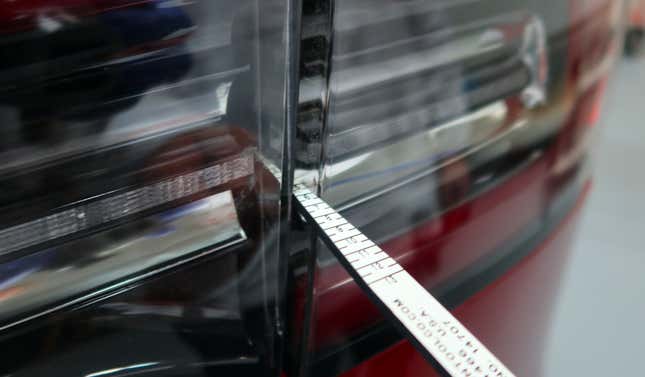
Granted, the Y has a giant hatchback door, so you’d expect it to be difficult to get perfect, especially considering that precision of the light attachment location adds another factor, as well. It’s worth mentioning that in terms of flushness, both sides were about the same at 2 mm between the inner and outer section of the taillight. How any of this compares to the competition, I don’t know, but the 2mm to 6mm delta does seem high.
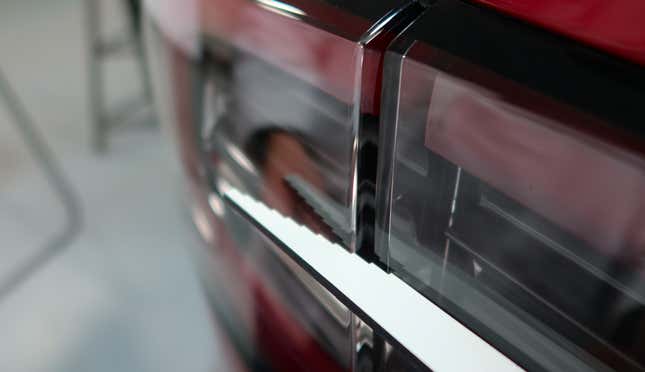
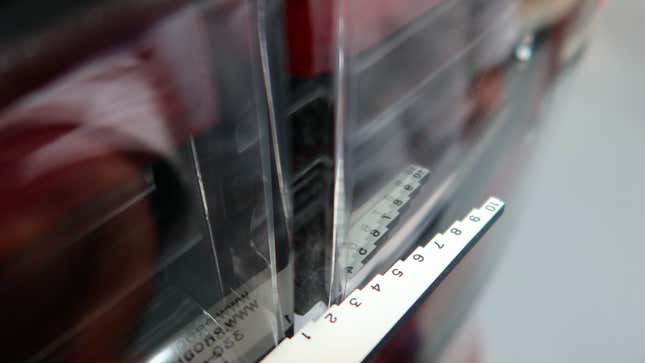
The panel gaps around the side doors were actually quite good, Steuben told me:

He even mentioned that the jamb for the rear hatch looked pretty decent, saying many automakers would require a trim piece in this channel to hide imperfections:
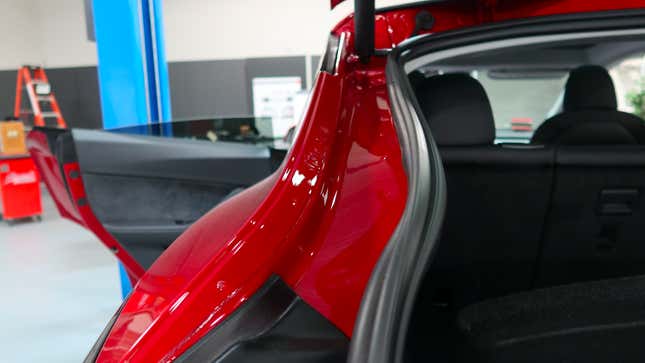
I will say that I did notice a paint drop at the tip of the passenger’s side fender near the light:
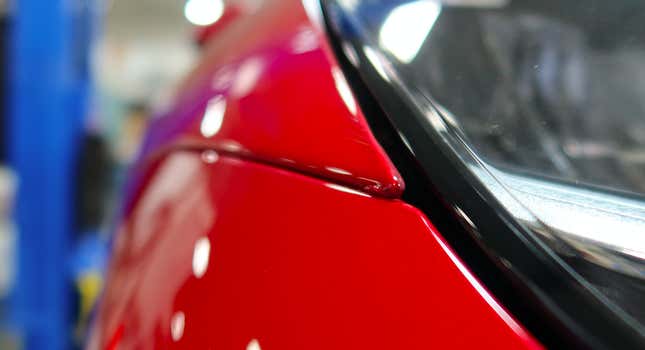
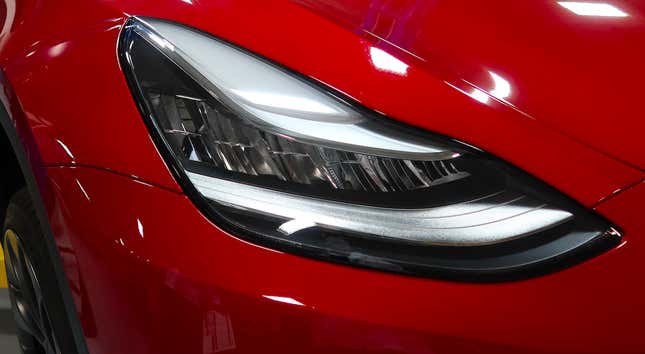
Despite not being perfect, Steuben told me, “...the Model Y, as a whole, [is] pretty good from a fit and finish perspective.”
Improved Welds
On top of that, Munro points out improvements to the body welds over the Model 3. On the 3, Munro noted self-piercing rivets installed from different directions, poor quality spot welds, and a strange mix of sinusoidal welds, spot welds, and self-piercing rivets on the door flange. From Motor Trend’s look at Munro’s breakdown:
Alternating Self-Piercing Rivets—These closely spaced rivets are alternately installed from the top and bottom. The Munro team is unaware of a structural benefit brought by this added complexity.
Overpowered Spot Welds—These resistance spot welds in steel show evidence of too much electrical power, which has caused molten metal to spray out. This issue may have since been resolved, as Munro was evaluating an early-production example, but Tesla could not confirm if that was the case.
[...]
Rear Door Opening—There is a curious mix of sine-wave tig welding along the roof rail, spot welds along the B-pillar and rocker, and self-piercing rivets along the (extra large) flange near the wheel opening. The rivets may be necessary to join steel and aluminum, but a simpler design overall would save cost.
As Sandy says in the video below, the Model 3's welds “looked like some sort of a science project.”
But the Model Y is different. “The distancing is great, the edge is perfect,” he says of the welds on the door flange, saying any automaker would be happy to have these kinds of welds on their cars. He also notes how the self-piercing rivets all come from just a single direction. “I’m really, really impressed with that,” he says.
Seat Risers

The Tesla Model Y’s front seats sit on “seat risers” to increase driver ride height while allowing the car to use the same seat/seat bracket design as the Model 3. Seat risers aren’t exactly novel for the auto industry, though the Y’s are pretty tall. Here’s a look from back to front. Notice how there’s an HVAC duct and a clear path directly to the pedals:
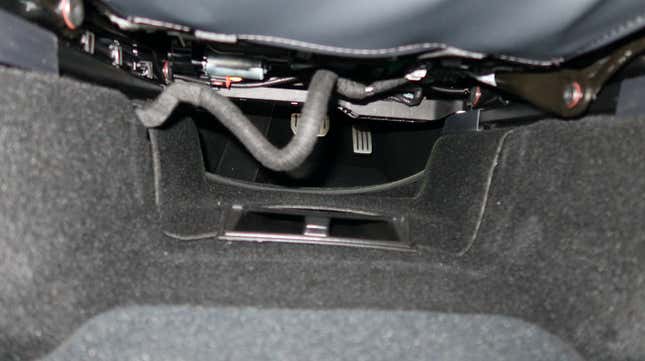
Munro took the seats and floor out to have a look at the risers. They’re just unpainted steel brackets bolted to the floor. Fairly simple:
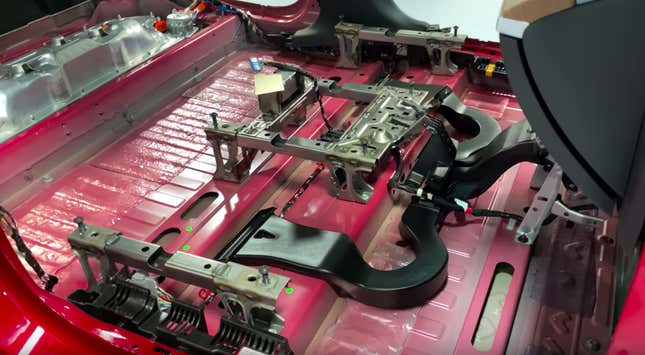
Those brackets are covered by a big piece of carpeting and expanded polypropylene, a foam that acts to raise the front floor, since it sits rather low (remember, the vehicle’s ride height isn’t much higher than the Model 3's (1.1 inches of added ground clearance), but the seating position is).

Seriously Clever Wiring
Another thing Sandy discusses is the cleverness of the Tesla Model Y’s wiring organization. For one, unlike on the Model 3, the Y uses aluminum pipes to carry the cables from the charge port to the battery:
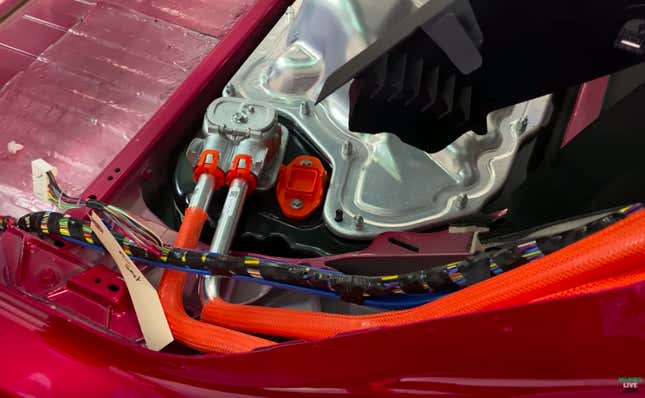
These, Sandy Mentions, are easier to install consistently in a precise location, lighter and smaller overall compared with the flexible cable found in the 3 shown below.

Sandy and Cory Steuben also noted that Tesla has pretty much all of its wires in split-loom tubing. Seriously, just look at all of the black, corrugated protective tubing in these photos. It’s everywhere:
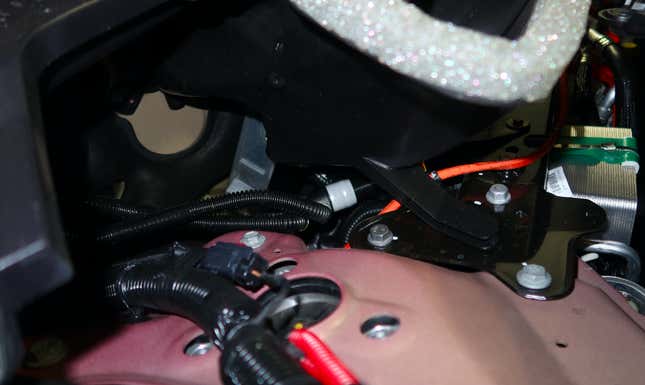
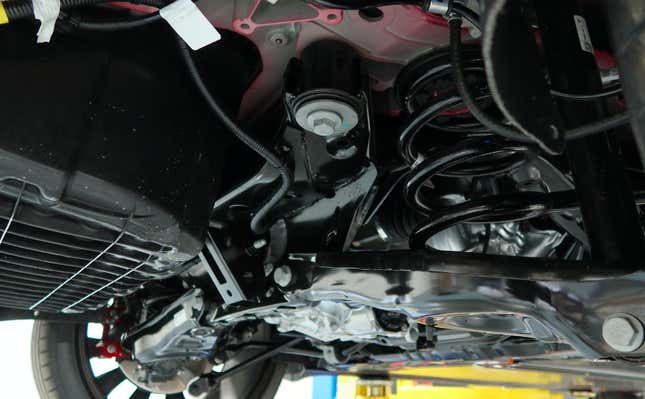
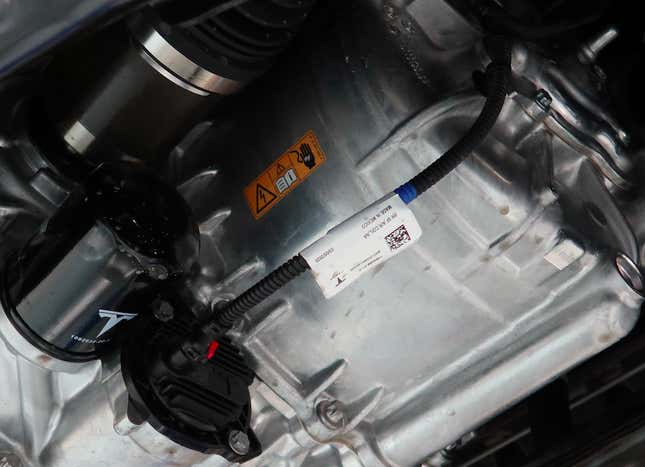
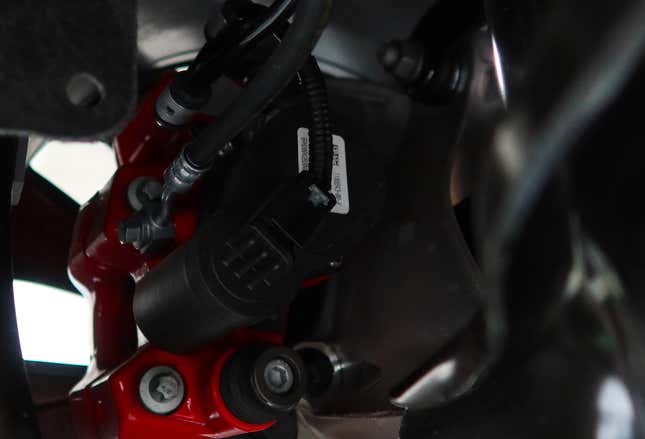
This should help the Model Y, and other Teslas that follow this same strategy, avoid electrical shorts. Most OEMs, Munro notes, tend to—in addition to looms—use “candy striping,” which basically just involves wrapping small wires in tape. “We’ve never seen anybody do this ever,” Sandy says of the extent of Tesla’s corrugated loom-intensive wire protection strategy.
Crash Performance And The Loudspeaker
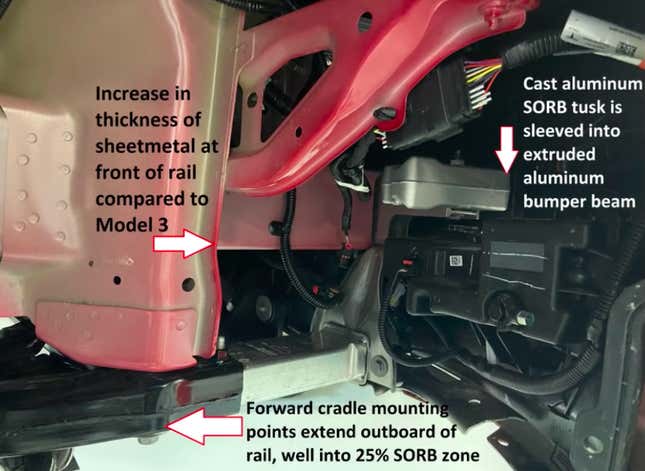
Sandy also talks about changes to the front crash structure to improve small overlap crash performance. The screenshot above shoes the increases in body-in-white metal thickness, the addition of a cast aluminum “tusk,” and the widening of the front suspension cradle mounting points.
“The front structure looks a lot different from what we remember from the Model 3, Sandy says. He also points out provisions for the noise alert system:

There are tiny holes built into the lower fascia to accommodate this feature, though this particular Y is not equipped with it.
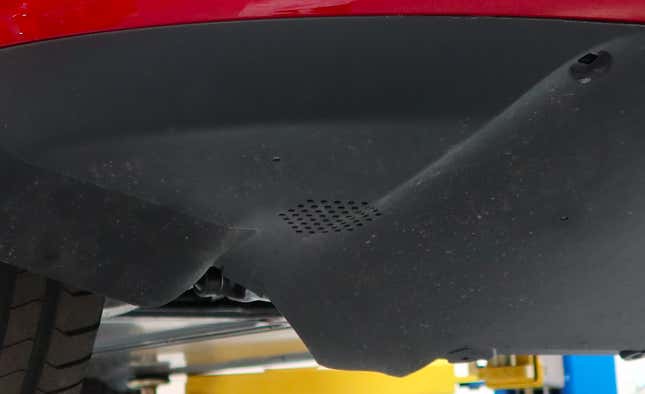
The Octovalve
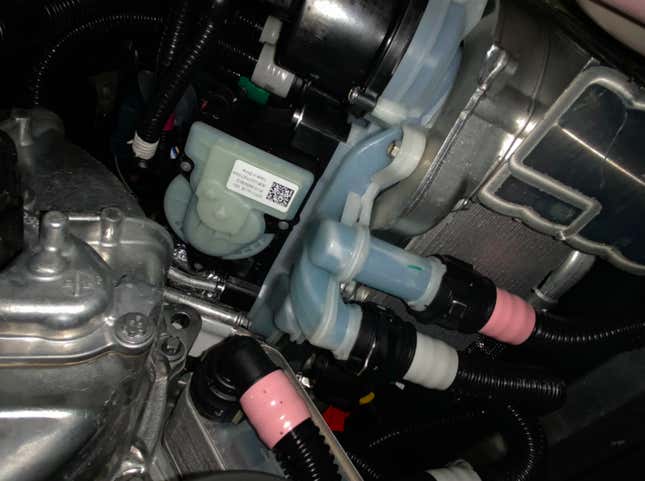
Jalopnik wrote a detailed article on the Tesla Model 3’s ingenious Superbottle—a coolant bottle with built-in valves, pumps, and a chiller which all shrank much of what would normally be a large and cumbersome cooling system into something elegant and compact. Now for the Model Y, that Superbottle has been replaced by the Octovalve.
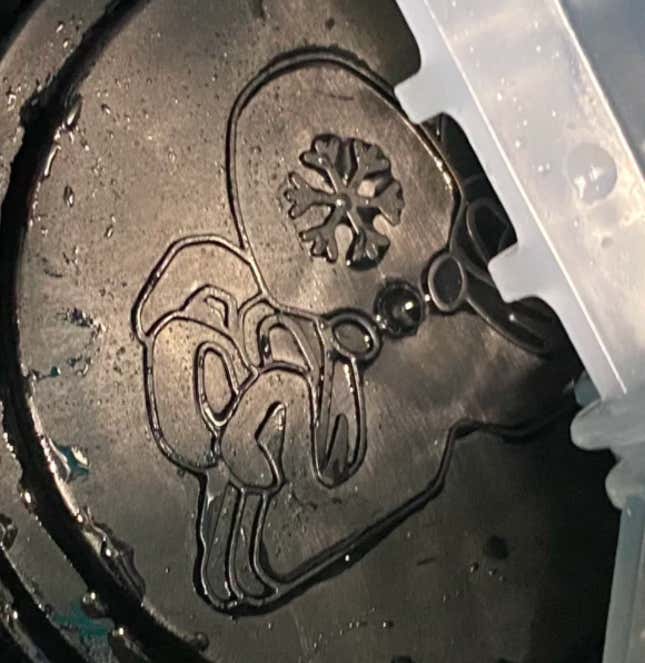
Munro is going to dig into it soon. Keep an eye on the company’s YouTube channel for more fascinating Model Y tech.